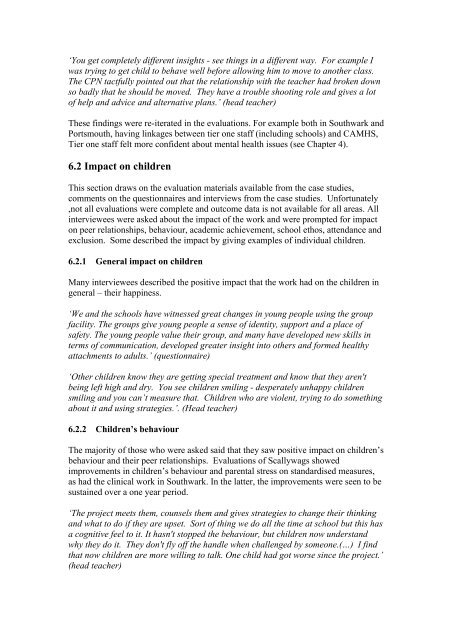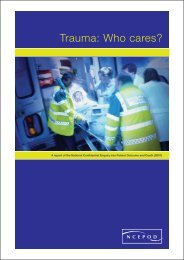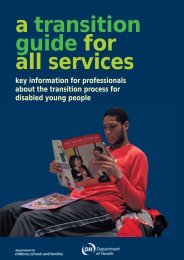(CAMHS) and Schools - London Health Programmes
(CAMHS) and Schools - London Health Programmes
(CAMHS) and Schools - London Health Programmes
You also want an ePaper? Increase the reach of your titles
YUMPU automatically turns print PDFs into web optimized ePapers that Google loves.
‘You get completely different insights - see things in a different way. For example I<br />
was trying to get child to behave well before allowing him to move to another class.<br />
The CPN tactfully pointed out that the relationship with the teacher had broken down<br />
so badly that he should be moved. They have a trouble shooting role <strong>and</strong> gives a lot<br />
of help <strong>and</strong> advice <strong>and</strong> alternative plans.’ (head teacher)<br />
These findings were re-iterated in the evaluations. For example both in Southwark <strong>and</strong><br />
Portsmouth, having linkages between tier one staff (including schools) <strong>and</strong> <strong>CAMHS</strong>,<br />
Tier one staff felt more confident about mental health issues (see Chapter 4).<br />
6.2 Impact on children<br />
This section draws on the evaluation materials available from the case studies,<br />
comments on the questionnaires <strong>and</strong> interviews from the case studies. Unfortunately<br />
,not all evaluations were complete <strong>and</strong> outcome data is not available for all areas. All<br />
interviewees were asked about the impact of the work <strong>and</strong> were prompted for impact<br />
on peer relationships, behaviour, academic achievement, school ethos, attendance <strong>and</strong><br />
exclusion. Some described the impact by giving examples of individual children.<br />
6.2.1 General impact on children<br />
Many interviewees described the positive impact that the work had on the children in<br />
general – their happiness.<br />
‘We <strong>and</strong> the schools have witnessed great changes in young people using the group<br />
facility. The groups give young people a sense of identity, support <strong>and</strong> a place of<br />
safety. The young people value their group, <strong>and</strong> many have developed new skills in<br />
terms of communication, developed greater insight into others <strong>and</strong> formed healthy<br />
attachments to adults.’ (questionnaire)<br />
‘Other children know they are getting special treatment <strong>and</strong> know that they aren't<br />
being left high <strong>and</strong> dry. You see children smiling - desperately unhappy children<br />
smiling <strong>and</strong> you can’t measure that. Children who are violent, trying to do something<br />
about it <strong>and</strong> using strategies.’. (Head teacher)<br />
6.2.2 Children’s behaviour<br />
The majority of those who were asked said that they saw positive impact on children’s<br />
behaviour <strong>and</strong> their peer relationships. Evaluations of Scallywags showed<br />
improvements in children’s behaviour <strong>and</strong> parental stress on st<strong>and</strong>ardised measures,<br />
as had the clinical work in Southwark. In the latter, the improvements were seen to be<br />
sustained over a one year period.<br />
‘The project meets them, counsels them <strong>and</strong> gives strategies to change their thinking<br />
<strong>and</strong> what to do if they are upset. Sort of thing we do all the time at school but this has<br />
a cognitive feel to it. It hasn't stopped the behaviour, but children now underst<strong>and</strong><br />
why they do it. They don't fly off the h<strong>and</strong>le when challenged by someone.(…) I find<br />
that now children are more willing to talk. One child had got worse since the project.’<br />
(head teacher)

















